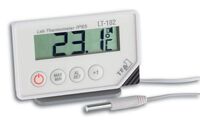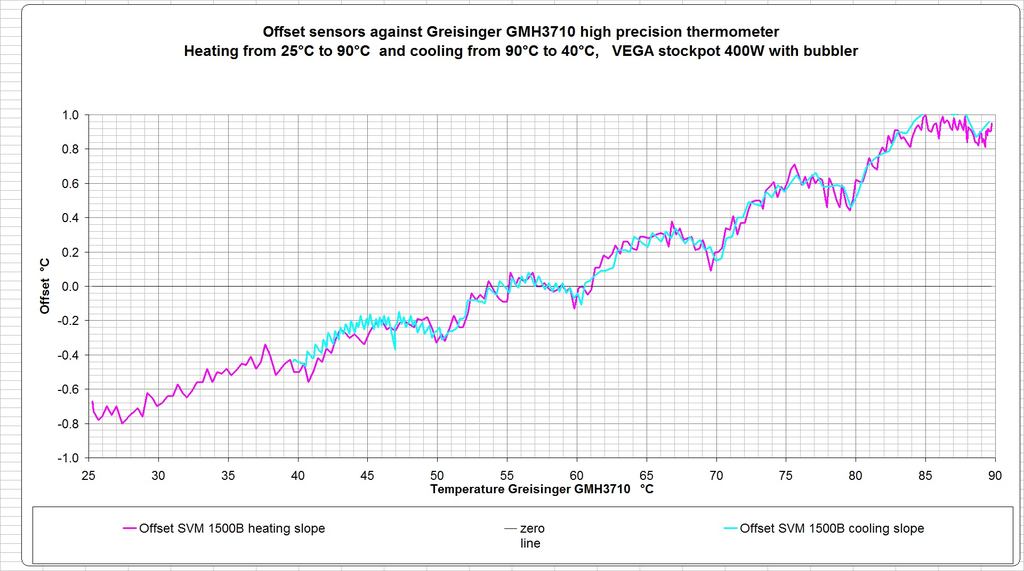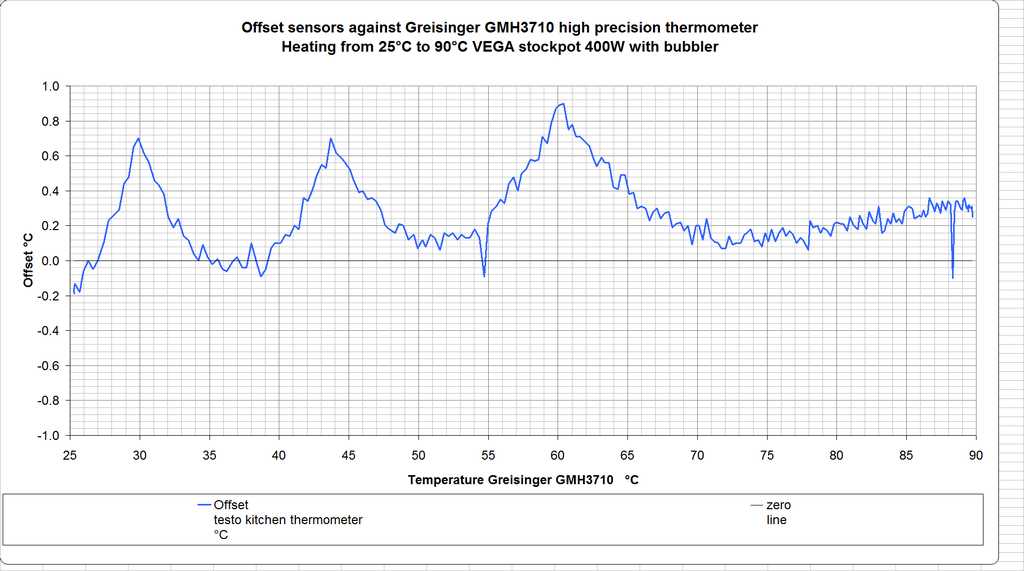Quintessence
- If you buy a new SousVide equipment which is calibrated at 55.0°C (131°F) to within ±0.1°C by the supplier (like e.g. PID-controller like the SVM1500D), then it is sufficient to calibrate against an ovulation thermometer at 38°C (100°F) immediately and recheck every couple of months. With water bath temperature stability ±0.1°C and sensor accuracy ±0.1°C, you are allowed to do longtime-cooking at 54.4°C (130°F), which is an arbitrary value at a 1.4°C safety margin above the 53°C at which any pathogens stop multiplying (see Douglas Baldwin’s Guide).
- If you have a unit which is not calibrated at 55°C, and you do not plan to double or triple the price of your SV-rig by buying a calibrated high-precision thermometer, then calibrate at 38°C (100°F) against an ovulation thermometer and hope you will be within ±0.5°C at 55°C. Longtime cooking below 55°C (131°F) would not be recommended in this case. Even in the worst case of being 1°C off, 54°C instead of 55°C is still 1°C above the 53°C mentioned above.
In both cases, it is highly recommended to have a cheap thermometer (not necessarily accurate, but with 0.1° resolution) with an immersion probe in the bath together with the controller's sensor, to get aware of eventual rapid sensor failure. Here is an example of such a cheap thermometer:

LT-102 laboratory immersion thermometer
Why is thermometer calibration so important?
In the case of cooking beef or pork to 55°C (131°F) core temperature for longer periods (i.e. longer than 4 hours) we have to navigate between the Scylla of safety (min. 54.4°C (130°F) to prevent growth and toxin production by clostridia) and the Charybdis of overdoneness. So if we want to cook to 55°C we are only 0.6°C away from the ominous 54.4°C, and thermometer tolerance plus waterbath temperature oscillation should not add to more than ± 0.25°C. At lower temperatures precision is not so crucial as you are in the "danger zone" anyway and have to restrict cooking time to less than 4 hours, and at higher temperatures you are at pasteurizing temperatures anyway. See also Importance of temperature control on pasteurizing times.
What thermometer to buy?
You need a working thermometer with an immersion probe (this may be the sensor of your PID-controller immersed in your water bath) which should have a resolution of 0.1°C or better, and you need a reference thermometer to calibrate your working thermometer at regular intervals. On the lower end of the price scale you may use a basal temperature thermometer (reading to 0.01°C from 32 to 43°C) as a reference, and on the other end of the price scale you may use a "Control Company Traceable® 4000" traceable to NIST standards (resolution 0.001°C/F, accurate within ±0.05°C, at $400), an ISO-calibrated Greisinger GMH3710/GMH3750 (resolution 0.01°C/F, accurate within ±0.06°F/0.03°C, at 253€ incl. probe and ISO-calibration) or the like. A valid alternative in the middle range of the price scale might be the Greisinger GTH 175/Pt (53€ excl.VAT) with resolution 0.1°C and accuracy ±0.25°C, also available with calibration to ±0.1°C (GTH 175/Pt -WPT2 at 108€ excl.VAT). New as of Feb. 2011 there is the Greisinger GMH 2710 accurate to ±0.1°C (105€ excl.VAT).
A bimetallic coil thermometer is not a satisfactory device for measuring food temperatures! See http://www.hi-tm.com/Documents/Bimet-pic.html
How to calibrate your working thermometer
Using a calibrated high precision thermometer (Traceable® 4000, Greisinger GMH3710), or the like (highly recommended): let your PID-Controller stabilize your waterbath at 55°C and measure its temperature with both the reference thermometer and the working thermometer (which may be the display of your PID-controller) and write the results down in your thermomater calibration logbook. Apply a note on your working thermometer indicating what the real temperature is when your working thermometer indicates 55°C.
Using a basal temperature thermometer (rather not recommended): let your PID-Controller stabilize your waterbath at 32°C, take measurements with both thermometers, and repeat the same procedure at least at 43°C, even better at a few more intermediate temperatures to get a more reliable regression line and correlation coefficient. Now plot your measurement pairs and extrapolate to 55°C (you may do this with an excel sheet [[1]]). Write the results down in your thermomater calibration logbook. Apply a note on your working thermometer indicating what the real temperature is when your working thermometer indicates 55°C.
Repeat calibration at regular intervals (at least every 2 months) to notice a drift of the sensor or the electronics! Sensors are known to drift after prolonged immersion in water.
Extrapolation from 32-43°C to 55°C may result in relevant errors, as I experienced with a sensor of the SousVideMagic 1500B or with a testo kitchen thermometer:
If I had calibrated my SousVideMagic 1500B at 35°C, it would show 55.5°C instead of 55.0°C.
Calibration of the testo kitchen thermometer against the Greisinger GMH3710 high precision thermometer showed an even more strange result:
With the new SousVideMagic 1500D the calibration curve is better:
So it really is best to calibrate your working thermometer against a calibrated precision thermometer at the temperature you are going to use, especially at the crucial 55°C, or to have your PID-controller and sensor calibrated by the supplier.
For regular recalibration, checking at 37°C or 38°C (100°F) against a basal temperature thermometer will be sufficient to notice a drift of the sensor.
--PedroG 23:20, 4 June 2009 (UTC) / 23:58, December 5, 2009 (UTC)


